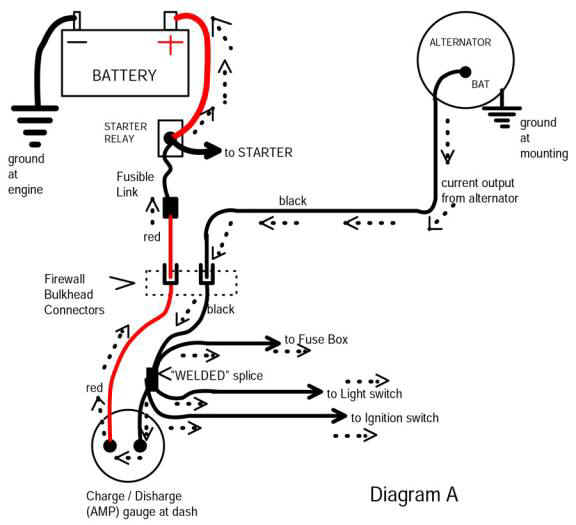Main dipped headlights not working
Your voltage reading list is confusing to me.
You have the
LIGHT SWITCH
This is the dash mounted switch which turns on the park, tail and head lights, and twisting the knob on that switch controls the dimming of the dash cluster illumination lamps
The light switch has TWO power sources
1....UNFUSED power (originally) came through battery---fuse link in the engine bay---bulkead connector (large red) ..........to ammeter......through ammeter.....large black........TO FACTORY WELDED SPLICE.......branch off to headlight switch. THIS WIRE IS HEADLIGHTS ONLY. It does not power dash lamps, tail/ park / marker lamps
2....Power for tail / park / marker / dash lamps comes from the tail fuse in the fuse panel, and of course this is hot all the time.
THE BUSS in the fuse panel which feeds that tail fuse gets it's power also from the WELDED SPLICE in the ammeter black ammeter wire.
Now, with the headlight switch turned on to headlamps, ONE wire feeds from the dash mounted light switch down to the foot operated dimmer switch. That is a simple SPDT switch which simply feeds that one wire power to one or the other output terminals
An aside, from the Mad Electrical article.....showing simplified primary wiring
Catalog

Notice the WELDED SPLICE branches off. There are NO fuses in that circuit except the "fuse link" which is poor protection. The ONLY protection for the headlight circuit is a built in circuit breaker in the headlight switch.
The following refers to the 68 PLYMOUTH manual as downloaded from MyMopar
MyMopar - Mopar Forums & Information - MyMopar Tools/Reference
This is only because there is no Dodge manual on that site for that year
68 Plymouth, page 335 (8-109)
"Front end lighting" The singe wires coming out of the bulkhead connector branch off and feed high beam and low beam filaments
"Y" in the bulkhead connector, wire L3-18R
and "X" in the bulkhead connector, were L418V
Those two wires come directly from the foot dimmer switch
NOTICE the grounding. NOTICE the grounding all connects to one point. "Single point of failure." That ground MUST be well made and in place. "Interesting" effects are caused if that ground is poor or broken due to backfeeds in the circuits.

Your voltage reading list is confusing to me.
You have the
LIGHT SWITCH
This is the dash mounted switch which turns on the park, tail and head lights, and twisting the knob on that switch controls the dimming of the dash cluster illumination lamps
The light switch has TWO power sources
1....UNFUSED power (originally) came through battery---fuse link in the engine bay---bulkead connector (large red) ..........to ammeter......through ammeter.....large black........TO FACTORY WELDED SPLICE.......branch off to headlight switch. THIS WIRE IS HEADLIGHTS ONLY. It does not power dash lamps, tail/ park / marker lamps
2....Power for tail / park / marker / dash lamps comes from the tail fuse in the fuse panel, and of course this is hot all the time.
THE BUSS in the fuse panel which feeds that tail fuse gets it's power also from the WELDED SPLICE in the ammeter black ammeter wire.
Now, with the headlight switch turned on to headlamps, ONE wire feeds from the dash mounted light switch down to the foot operated dimmer switch. That is a simple SPDT switch which simply feeds that one wire power to one or the other output terminals
An aside, from the Mad Electrical article.....showing simplified primary wiring
Catalog

Notice the WELDED SPLICE branches off. There are NO fuses in that circuit except the "fuse link" which is poor protection. The ONLY protection for the headlight circuit is a built in circuit breaker in the headlight switch.
The following refers to the 68 PLYMOUTH manual as downloaded from MyMopar
MyMopar - Mopar Forums & Information - MyMopar Tools/Reference
This is only because there is no Dodge manual on that site for that year
68 Plymouth, page 335 (8-109)
"Front end lighting" The singe wires coming out of the bulkhead connector branch off and feed high beam and low beam filaments
"Y" in the bulkhead connector, wire L3-18R
and "X" in the bulkhead connector, were L418V
Those two wires come directly from the foot dimmer switch
NOTICE the grounding. NOTICE the grounding all connects to one point. "Single point of failure." That ground MUST be well made and in place. "Interesting" effects are caused if that ground is poor or broken due to backfeeds in the circuits.